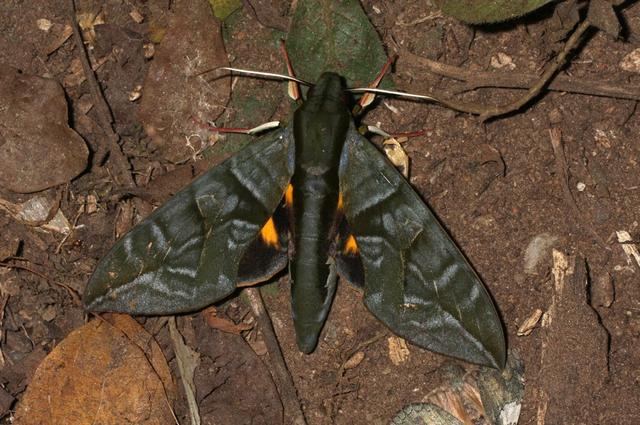Sphingidae: Philampelini: Eumorpha of Colombia
Eumorpha phorbas, Shima, Junin, Peru,
June 12, 2010, courtesy of Peter Bruce-Jones.

Eumorpha phorbas, Shima, Junin, Peru,
June 12, 2010, courtesy of Peter Bruce-Jones.
HUMBERTO CALERO MEJIA, Estudiante de Biología, Socio Fundacion SAMANEA.
"I am a student of biology at the Universidad del Valle, Cali, Colombia. Right now my grade development in the Colombian Pacific island called Gorgona, where I
perform the update of the diurnal species list and try to generate the initial list of moths (Saturniidae and Sphingidae).
"As is well known in sphingidos website, in our country is not known a solid list for this group and would like to help improve the list of my country. You can
suggest me identification keys for the family to help me in my studio. On February 21 I have a field trip to collect the material, if you can give me tips to
improve collections sphingidos appreciate it.
"In my university library I found a research Amarillo (1998) which evaluates the moths as bio-indicators in the recorded seventeen sphingidos:
Adhemaius gannascus
Bibliographical source:
"Thank you very much for your attention and I hope to contribute to the rise of a more extensive list and information will be of great help."
Email: Humberto writes, February 12, 2011:
Callionomia nomius
Ennyo ocypete
Erinnyis alope; E. obscura; E. ello
Eumorpha anchelomus
Manduca diffisa; M sp nr. hannibal; M. sp. nr. pellenia; dos especies mas hasta genero
Protambulyx sp. nr. strigilis
Xylophanes juanita; X. pluto; X. undata; y una especie hasta genero
Amarillo A. 1998. Uso de polillas (lepidopetra: heterocera) como bio indicadores del estado de conservación del ecosistema. Informe final. Fundación para la
promoción de la investigación y la tecnología. Santa fe de Bogota. 46 pag. This is a very tentative checklist based
primarily on checklists for Costa Rica, Venezuela and Ecuador so I fully expect
there are omissions and some erroneous inclusions. If you have
corrections to offer, please contact
Many thank to Gregory Nielsen who has been sending me images and data from Villavicencio, Meta, Colombia.
Bill Oehlke at
oehlkew@islandtelecom.com.
|
Go to Indices of Nations
+++++++
Use your browser "Back" button to return to the previous page.
Visit Sphingini: Manduca
Visit Sphingini: Agrius, Amphimoea, Cocytius, Euryglottis, Lintneria, Sphinx
Visit Smerinthini: Adhemarius, Orecta and Protambulyx
Visit Dilophonotini: Aleuron, Enyo, Pachygonidia and Unzela
Visit Dilophonotini: Aellopos, Eupyrrhoglossum, Nyceryx and Perigonia
Visit Dilophonotini: Callionima, Erinnyis, Hemeroplanes, Isognathus, Madoryx, Oryba, Pachylia, Pachylioides, Phryxus
and Pseudosphinx
You are here: Philampelini: Eumorpha
Visit Macroglossini: Hyles and Xylophanes
This page is brought to you by
Bill Oehlke and the
WLSS. Pages are on space rented from Bizland. If you would like
to become a "Patron of the Sphingidae Site", contact Bill.
Please send sightings/images to Bill. I will do my best to respond to requests for identification help.
 Show appreciation for this site by clicking on flashing butterfly to the left. The link will take you to a page with links to many insect sites. |